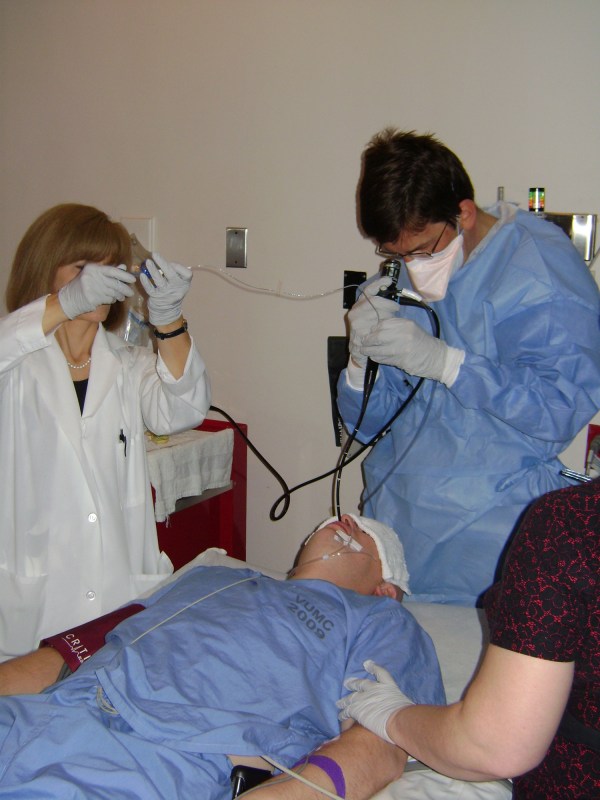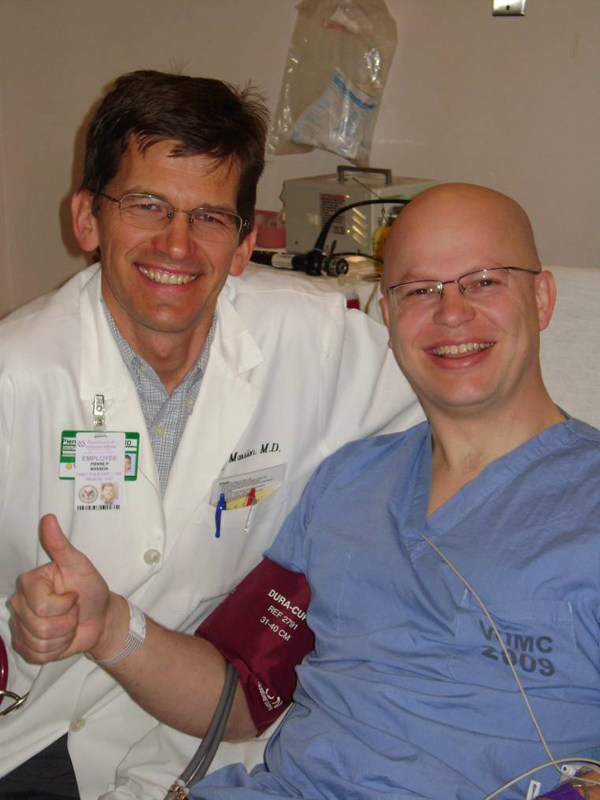
Pierre Massion, M.D., performs a bronchoscopy on Otis Rickman, D.O., who volunteered in order to better communicate with his patients about what the procedure entails. (photo by Charla Atkins)
Being on receiving end of study changes perspective
Otis Rickman, D.O., assistant professor of Medicine and Thoracic Surgery, has performed thousands of bronchoscopies; after all it's his medical specialty.
But VUMC's director of Bronchoscopy had never undergone the procedure, which involves threading a flexible scope through a patient's nose, down the airway and into the lungs. The lighted bronchoscope makes it possible for the physician to see and access lung tissue without performing more invasive surgery.
“I have explained it to patients, but many of them asked me how I knew what it felt like and I didn't really have an answer,” said Rickman.
So Rickman signed up as control subject for a lung cancer research study by his colleague, Pierre Massion, M.D., associate professor of Medicine and Cancer Biology. The study is designed to identify biomarkers for the development of lung cancer.
“We are conducting bronchoscopies on patients who are older than 50 with a heavy smoking history and who are at high risk for lung cancer, but may not have any signs of lung cancer yet,” explained Massion.
Lung cancer is the No. 1 cause of cancer death in the country. But there is no early diagnostic test for the disease, so most patients are diagnosed at a late stage when the disease may be incurable.
“Only about 15 percent of people who smoke for a lifetime end up having lung cancer and we don't know who they are, so we are searching for biological markers that can identify those people who are at risk,” explained Massion.
Massion also needs to sign up healthy volunteers willing to undergo a bronchoscopy.

Rickman, right, and Massion were all smiles after the procedure, which was done without anesthesia. (photo by Charla Atkins)
“We will compare the tissue specimens from individuals who are totally “normal” — that is, without the risk factors, with specimens from patients who are high-risk smokers with or without lung cancer. We hope the study helps us identify markers that tell us who is at higher risk for developing lung cancer,” he said.
Eventually, Massion and his colleagues hope to develop a blood test based on the molecular analysis of tissue specimens, with the goal of diagnosing lung cancer without touching the tumor.
For Rickman, going the extra mile to contribute to the science of lung cancer diagnosis made perfect sense, even if it meant undergoing the procedure without general anesthesia.
“I did it without any sedation, except localized numbing, because I wanted to be able to remember what it was like so that I could explain it to my patients,” said Rickman.
For this procedure, Rickman lay flat on a table and Massion inserted the bronchoscope through the nose, into the airway and down into the lungs. Massion then used tiny brushes to gather cells from inside the lungs. Each specimen was carefully transferred into a tube, which was labeled for the study.
Rickman, who has almost never been on the receiving end of a medical procedure, found the process “a little surreal.”
“Just the process of putting on the EKG pads and the blood pressure cuff, and saying, 'Now you can invade my private space,' was different. We do this to patients all the time, but the loss of autonomy for patients and the trust that is required is pretty humbling,” said Rickman.
Rickman also has a better understanding of how to communicate with patients whose eyes are covered during the procedure.
“Now I can say, 'This will feel cold and it will make you cough,' and it will be easier for the patient,” said Rickman.
Twenty minutes after he had recovered from the procedure, Rickman was sprinting down the hospital corridor to perform a bronchoscopy on one of his own patients. This time, he knew just what to say.













